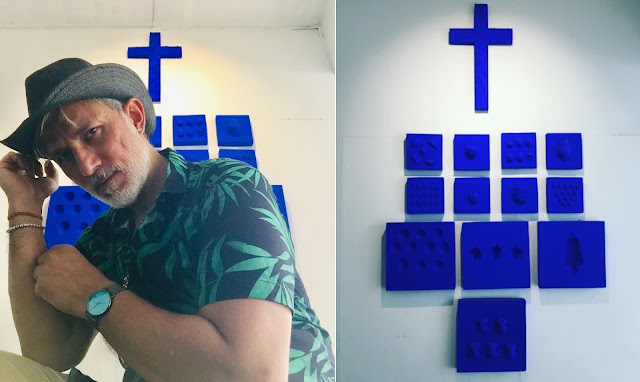#ARTISEVERYWHERE: GOA'S MUSEUM OF COLONIZATION (MY NDTV-MOJARTO COLUMN)

The writer with the installation that especially caught his eye
Dhiraj Singh | 21st January 2022
This Christmas I happened to be in Goa. Actually, the ‘happened to be’ part was in reality: ‘made the impossible seeming Goa trip happen’. But it was great fun. And it involved driving around the place, meeting some old friends and avoiding meeting some others who also happened to be in Goa.
There is something about the place that comes alive during Christmas. It was my first Christmas in Goa and even though I was prepared to be accosted by the usual Goa clichés I was pleasantly surprised. One of the things that saved me from the clichés were these skillfully placed road signs about something called ‘MOG’. Fascinated by these visual breadcrumbs I decided to follow them and reach MOG on Christmas noon itself.

The Vasco da Gama painting in the main hall & detail (right)
MOG or Museum of Goa turned out to be a telescoping probe into the heart and soul of Goa in very unexpected ways. It is the labour of love of Subodh Kerkar, an artist who has been quietly creating a vast and diverse body of work in his native state for decades. But what makes his Museum of Goa truly unique is that Kerkar uses his art as well as the art of other artists to deep-dive into Goa’s psychogeography. This is truly a noble effort because a lot of Indian art fails to take the viewer to unexpected places. Into the deep, sunken bits of ourselves that make us who we are, collectively and individually.
Goa too is like that, a ship that has travelled many places and has now sunk its anchor on the Indian peninsula. It’s a place of the sea created by the toil of fishermen, the wicked ingenuity of spice merchants and the opportunism of later politicians—today’s Goa has legislated some fine laws to keep its monopoly on fun and good times with its liquor permits and its floating casinos. It is where the Portuguese armadas did their India Runs, and whose seamen later became settlers and then colonizers. An equally evocative narrative is of Parashurama’s, the avatar of Vishnu who settled here after all his battles were won (even God rested in Goa!).
Kerkar’s Goa is a mix of the ancient and the contemporary. There is a fresh-off-the-boat Vasco da Gama ordering sleeping natives to action in the Museum’s main hall. There is a giant bull at the entrance made entirely of construction rods, raising its head at some distant threat. A boat full of idols of gods and goddesses escaping Goa under yet another Christianizing wave by Portuguese priests, I say yet another because there were many. Goa unlike the rest of India was under colonial rule for about 450 years. And every event that occurred in the European home of the rulers had an equal impact in the places ruled by them. So you can well imagine what happened in Goa during the Inquisitions and witch-hunts of Europe!

Subodh Kerkar’s shells and chillies
In the Museum, there are also magnificently attired chillies that the colonials introduced to Goa but which spread faster than their religion and which since their arrival have been burning and scalding tongues and guts of lesser chilly-tolerant mortals like myself. And then there are shells that adorn almost every other work in the Museum. And never do their presence seem exaggerated. They are after all the thing closest to homes found anywhere in the animal kingdom apart from humans. They are also highly individuated and tend to survive almost as long as human homes.
An indigo shrine especially caught my eye because it punned on two similar-sounding words: DIES and DYES. Dies or moulds of fruits and nuts of Goa all dyed blue, including a cross that presides over the whole formation was particularly evocative of Goa’s past as a trading port that grew so rich with jobs and opportunities that it became a country within a country. In today’s terms that would be the equivalent of Microsoft declaring its IT Park in Bengaluru or Hyderabad to be a province of the Microsoft corporation. Such things have happened in the past and there’s really no saying that they won’t happen again. Kerkar’s Museum of Goa is trying to keep that memory alive for the future.
Dhiraj Singh is a well-known journalist, writer, TV personality and artist who has shown his abstract paintings and X-Ray works in India and abroad. He is currently Director, School of Media & Journalism & The Idea Lab, MIT-World Peace University, Pune


Comments
Post a Comment